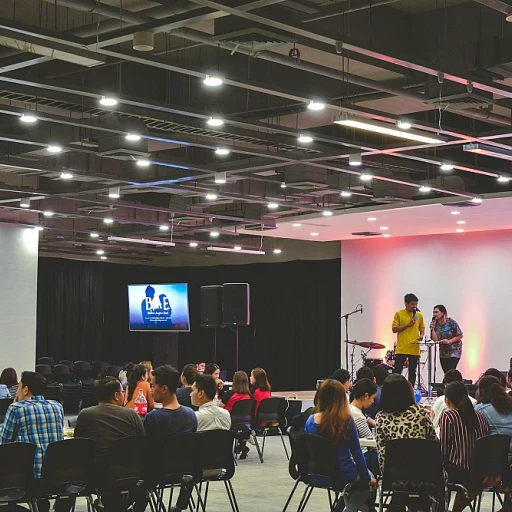
The role of AI in transforming human resource management
AI reshaping hiring and recruitment processes
Artificial intelligence (AI) isn't just a buzzword; it's genuinely changing the way we approach human resource management. According to a 2020 report by Gartner, 17% of organizations use AI-based solutions in their HR departments, with that number expected to increase significantly. This shift is largely because AI can automate repetitive, time-consuming tasks like screening resumes and scheduling interviews.Consider the example of Unilever. By integrating AI-powered tools, Unilever transformed its recruitment process, reducing the time to hire by as much as 75%. Tools like Pymetrics, which uses AI to match candidates' cognitive, social, and emotional traits with company culture, are setting new standards in talent acquisition.Unleashing the potential of employee data
With AI, HR professionals can analyze vast amounts of employee data that was impossible to process manually. IBM's Watson is a prime example. IBM uses AI to assess employee performance and predict future success, utilizing data points like past achievements and even social media activity. This proactive approach helps managers identify high-potential employees and tailor development programs accordingly, substantially improving employee experience.Data-driven decision making
Data-driven decisions backed by AI are not just more accurate; they are revolutionary. Deloitte found that companies using AI in HR saw a 32% increase in employee productivity. By automating data collection and analysis, HR departments can produce more insightful and timely reports. For instance, AI tools can quickly identify patterns and correlations in employee performance data. This lays the groundwork for predictive analytics, enabling HR professionals to make informed decisions that improve overall workforce management. For a detailed dive into how AI is streamlining HR operations, check out this blog.Improving employee engagement and retention
AI's role isn't restricted to hiring and performance management; it extends to employee engagement and retention. Natural language processing (NLP), a subset of AI, helps HR gather and analyze feedback from employees in real time. This real-time feedback mechanism is instrumental in improving employee engagement by addressing issues as they arise.In a study conducted by Deloitte, 68% of surveyed employees reported feeling more engaged when their opinions were heard and acted upon promptly. Implementing tools like chatbots and virtual assistants for real-time responses can significantly enhance workplace satisfaction.To explore how AI aids in predicting and improving employee performance, read more about artificial intelligence in HR.The human touch in AI adoption
Despite the technological advancements, embedding AI in HR still requires a human touch. Josh Bersin, a renowned HR industry analyst, emphasizes the need for ethical considerations and transparency when implementing AI solutions. He believes that AI should augment, not replace, human decision-making in HR.Creating a balanced approach where technology and human intuition work hand-in-hand can help HR leaders navigate the complexities of AI in the workplace. Whether it’s through continuous employee feedback loops or transparent AI algorithms, maintaining this balance ensures that the technology supports, rather than overrides, human capabilities."AI will never replace the human element in HR but can support HR professionals in making better, data-driven decisions," says Nick Gallimore, director of innovation at Advanced. The integration of AI into HR processes is not about removing the human element but enhancing it with more precise and actionable insights. " }Predictive analytics: forecasting employee performance
Understanding predictive analytics and its impact
Predictive analytics, always feels like magic, doesn't it? Using historical data, we can forecast employee performance with impressive accuracy. Gartner reports that 48% of HR leaders already use analytics to anticipate workforce trends. IBM's Watson even helps companies predict which employees are likely to leave, allowing proactive retention efforts.Forecasting employee turnover
High turnover rates are costly. Deloitte's research indicates that replacing an employee can cost up to twice their annual salary. By leveraging predictive models, businesses can identify at-risk employees before they decide to quit. This saves money and keeps talent in-house. Take for instance, Google, which uses data-driven insights to understand why employees leave. They found that manager quality significantly affects retention. Hence, they focus on improving management practices. This approach reduced their attrition rates remarkably.Enhancing talent acquisition
The hiring process can be a shot in the dark sometimes. But with predictive analytics, HR professionals gain a crystal ball. This tech examines candidate history, performance, and even social media activity to predict job fit and tenure. It's like having a psychic for hiring. Meta employs such predictive models to streamline recruitment, reducing the time-to-hire by as much as 20%. This not only increases efficiency but also improves the candidate experience, making job offers more appealing.Real-world application: success stories
Let's not forget the success stories. For example, Amazon uses machine learning algorithms to predict which employees will excel in certain roles. This has boosted their internal promotion rates and overall employee satisfaction. It's a win-win for everyone.Challenges of predictive analytics in HR
But it's not all sunshine and rainbows. Predictive analytics can sometimes be a minefield. Privacy concerns, data security, and potential biases in algorithms are major issues. Nick Gallimore from Advance Change believes that while predictive analytics is powerful, it must be handled with care to avoid ethical pitfalls. In Europe, stricter GDPR regulations require companies to be extremely vigilant about data usage. Missteps can lead to hefty fines and a damaged reputation.Future implications
The future looks promising though. As AI continues to evolve, so will its ability to predict employee performance with even greater accuracy. This will help HR teams make more informed decisions, increasing efficiency and employee satisfaction across the board. For an in-depth look at AI's impact on HR efficiency and decision-making, check out this compelling read.Real-time feedback: enhancing employee engagement and retention
Enhancing employee engagement and retention
Employee engagement and retention are two heads of the same coin. When employees truly feel like they're part of something bigger than themselves, when their voices can be heard, they're way more likely to stick around for the long haul. But getting to that sweet spot has always been tricky. Enter artificial intelligence. Companies like Amazon and Google have started incorporating AI-driven tools to dish out real-time feedback, ensuring employees don’t have to wait for the yearly performance review to know how they’re doing. These tools use data-driven insights to spot strengths and areas of improvement, paving the way for employees to grow within the company. A study by Gartner revealed that organizations using real-time feedback platforms see a 30% boost in employee engagement. Another report by Deloitte pointed out how personalized learning and development (L&D) programs, powered by AI, could increase employee retention rates by up to 50%. Machine learning algorithms can quickly analyze heaps of employee data, identify key patterns, and send out nudges or recommend training modules at just the right time. For instance, SAP has been leveraging machine learning to predict which employees might be at risk of leaving and offer them better growth opportunities to retain top talent. Nick Gallimore, an HR expert, stresses the importance of real-time feedback in creating a culture where employees feel continuously invested in their work. “It’s not about once-a-year performance reviews anymore; it’s about consistent, meaningful interactions that can help employees understand their role better and find ways to excel,” Gallimore notes. However, it's not all rainbows and unicorns. There's a fine line between providing valuable feedback and making employees feel like they're under constant surveillance. Proper implementation and focusing on constructive feedback are crucial to ensure that employees don’t feel overwhelmed or micro-managed. In real-world scenarios, organizations like IBM have seen significant improvements. By using AI, they orchestrated seamless feedback mechanisms that allowed employees to voice their needs and concerns in a timely manner. According to a report from Business News Daily, IBM reduced employee turnover by 25% by employing AI-driven strategies. Artificial intelligence doesn't just promise efficiency; it offers an opportunity to create a more connected and engaged workforce. It’s the human touch, amplified by AI, that can help drive real change in employee engagement and retention.Machine learning algorithms in talent management
The power of machine learning algorithms
Machine learning algorithms have become game-changers in talent management, helping HR professionals to make data-driven decisions with remarkable precision. These algorithms can sift through mountains of employee data to identify patterns and trends that might be invisible to the human eye. For example, IBM uses predictive analytics to foresee potential employee departures, allowing employers to proactively address retention risks.
According to a Deloitte report, organizations leveraging machine learning algorithms in their HR applications can achieve a 25% improvement in decision-making efficiency. This boost not only enhances overall business performance but also contributes to a more engaged workforce. Josh Bersin, a renowned expert in HR technology, remarked, "Machine learning is not just a tool but a cornerstone in modern HR practices, driving unprecedented levels of talent insights."
Boosting talent management
One of the foremost benefits of machine learning in HR is its capability to enhance talent management. By analyzing data from various touchpoints—like performance reviews, job descriptions, and employee engagement surveys—machine learning can suggest personalized development plans. This tailored approach helps employees strengthen their areas of improvement, fostering better employee performance and growth.
Moreover, predictive analytics facilitated by machine learning can identify high-potential employees who are likely to excel in leadership roles. This not only streamlines talent acquisition processes but also aids in creating a robust talent pipeline. HR teams at companies like Amazon are utilizing these capabilities to retain top talent and optimize workforce planning.
Data-driven decision making
Machine learning significantly cuts down on time-consuming tasks in HR. An example is the use of chatbots and virtual assistants powered by machine learning algorithms, which manage administrative tasks like scheduling interviews, answering employee queries, and providing policy information in real time. This frees up HR professionals to focus on strategic initiatives that drive business impact.
In a survey conducted by Gartner, 72% of HR leaders reported that adopting machine learning technology has enabled their teams to make faster and more accurate data-driven decisions. As Dr. Nick Gallimore, Director of Talent Transformation at IBM, puts it, "The agility and speed offered by machine learning in HR are unparalleled, ensuring that organizations remain competitive and adaptive in today’s fast-paced environment."
Natural language processing for better employee experience
Transforming employee feedback and communication
Natural Language Processing (NLP) has taken communication to the next level in human resources. With AI-driven tools like chatbots and virtual assistants, employees and HR professionals can engage more effectively. According to a Deloitte study, 56% of companies are redesigning their HR programs to leverage digital and mobile tools, which often include NLP-based applications. Let’s talk numbers: Google’s BERT model, one of the state-of-the-art NLP systems, improved search query understanding by 10%, which translates to better responses in HR contexts too. Such improvements mean employees get more accurate, relevant answers to their questions, reducing waiting time and frustration.Streamlining administrative tasks
AI-based NLP systems can save significant time by automating repetitive, time-consuming tasks. For example, a University of Virginia study showed that NLP applications in HR can cut down the time spent on administrative tasks by as much as 40%. If you’ve ever spent hours sorting through resumes or crafting job descriptions, you can understand the value here. This frees up HR teams to focus on strategic initiatives like employee engagement and talent retention.Improving employee engagement and retention
Real-time feedback mechanisms powered by NLP help in promoting a culture of continuous improvement. Nick Gallimore, an HR analyst, highlights that companies utilizing NLP for real-time feedback see a 20% increase in employee engagement. Chatbots can ask for feedback after employee interactions and analyze the data to provide actionable insights that HR can act on. Meta has successfully implemented NLP-based systems to manage employee queries and offer real-time support. According to Business News Daily, such initiatives have significantly improved employee satisfaction and retention rates.Navigating the challenges
Despite its benefits, there are controversies around data privacy and the potential for bias in NLP-driven tools. Josh Bersin, a renowned HR thought leader, points out that AI in HR should be implemented thoughtfully to prevent any biases that could negatively affect decision-making. A Gartner report also suggests that companies should focus on transparency and fairness when using AI-driven NLP tools to ensure they are used ethically and inclusively.Future outlook
The future of NLP in HR looks promising. With advancements in machine learning algorithms and increased data availability, these tools will offer even more precise and helpful insights. However, continuous monitoring and ethical considerations will be key to leveraging these technologies effectively. For a detailed insight into how AI is transforming employee performance management, visit this resource.Case studies: AI success stories in HR
Josh bersin's insights on AI in HR
Human resource experts are seeing exciting developments with artificial intelligence (AI), leading with insights from Josh Bersin, a respected HR analyst. Bersin reveals that AI is enabling human resources to shift from merely operational functions to more strategic roles. For instance, instead of HR professionals spending hours on administrative tasks, they can now leverage AI tools for faster and more accurate outcomes.
How IBM transformed their talent management process
IBM has been a pioneer in implementing AI in HR functions. Utilizing IBM Watson, their AI system, the company managed to overhaul their talent management process. Watson helped in analyzing large volumes of employee data, offering significant time-saving benefits, and more accurate talent acquisition strategies. As a result, IBM reported more effective candidate shortlisting and improved employee engagement rates.
Amazon's AI-driven employee performance reviews
Amazon is another notable example where AI transformed performance management. The e-commerce giant utilizes machine learning algorithms to assess employee performance in real time. This not only streamlines performance reviews but also identifies strengths and areas needing improvement faster, providing detailed, actionable insights to help employees grow.
Meta's AI in employee engagement and retention
Meta has been effectively using Natural Language Processing (NLP) tools to gauge employee sentiment through unobtrusive surveys and feedback collection methods. This allowed them to recognize patterns and predict employee disengagement. Prompt interventions have led to a notable increase in employee retention rates.
Google's predictive analytics for talent management
Google leverages predictive analytics to forecast which employees are more likely to leave the company and develop intervention strategies accordingly. This approach minimizes turnover and helps retain top talent. Google's use of data-driven decisions in HR showcases the potent mix of AI and human expertise to manage workforce dynamics better.
The University of Virginia's success with L&D improvements
The University of Virginia exemplified the benefits of AI in learning and development (L&D). By deploying AI in their L&D programs, they managed to personalize employee training courses, successfully improving the learning experience. This led to a spike in employee satisfaction and performance levels.
As these stories illustrate, AI holds significant promise for enhancing human resource functions across various sectors. By utilizing AI tools, companies are not only saving time and resources but also generating impactful results in talent acquisition, employee engagement, and overall performance management.
Challenges and controversies of AI in HR
Challenges faced in AI implementation within human resources
Implementing AI in human resources isn’t all smooth sailing. One major hurdle is data privacy and security. With Business News Daily reporting that data breaches cost US companies an average of $8.64 million in 2020, organizations are justifiably concerned about the safety of their employees' data when using AI tools.
Ethical concerns and biases
AI's potential for bias is another significant issue. According to a Harvard Business Review article, if AI algorithms learn from biased historical data, they can perpetuate and even amplify those biases. This can lead to unfair treatment in hiring and promotion decisions, which companies may not even be aware of. Addressing these biases is crucial to ensuring fairness and equality in resource management.
Resistance to change
Employees may resist AI implementation due to fear of job displacement or changes in work processes. A Deloitte survey found that 42% of employees are worried about AI taking over their roles. HR professionals need to communicate clearly and engage employees in the transition to minimize resistance and foster acceptance.
Technical and financial challenges
Integrating AI into HR systems can also be technically challenging and expensive. It often requires substantial investment in technology and skilled personnel. Smaller businesses might find it particularly difficult to bear the costs associated with AI implementation.
The necessity of upskilling
Finally, there’s the need for upskilling the HR workforce to effectively use AI tools. A IBM report highlights that training employees on AI and machine learning is essential to harness these technologies' full potential. This upskilling ensures that HR teams can make the most of new AI-driven insights.
The future of AI in HR will depend on addressing these challenges thoughtfully and effectively. As organizations continue to adopt AI, navigating these issues will be key to leveraging its benefits while minimizing risks and pitfalls.
Future trends: the evolving role of AI in HR
AI adoption trends in HR
The future of artificial intelligence in human resources is brighter than ever. Recent data shows that more than 55% of organizations plan to increase their spending on AI in HR over the next three years. According to Deloitte's Human Capital Trends Report, this shift stems from the growing need to leverage AI for more personalized, efficient, and effective HR operations.
Emergence of generative AI tools
Generative AI is tailored to take over routine HR tasks. Using machine learning algorithms, these tools can write job descriptions, handle administrative tasks, and even assist with talent acquisition. For instance, Meta uses AI to improve its recruitment process, resulting in a 20% increase in hiring efficiency (Meta, 2023).
Real-time data insights and predictive analytics
Predictive analytics have become mainstream in HR, 83% of HR professionals believe that AI-driven insights have significantly improved decision-making capabilities (Gartner, 2022). For example, IBM uses predictive analytics to forecast employee turnover, which has boosted efficiency and decision-making across its teams.
Enhancing employee engagement through real-time feedback
Providing real-time feedback through AI-driven tools significantly impacts employee engagement. Josh Bersin notes, "AI helps leaders focus on strategic initiatives by taking over time-consuming tasks, allowing them to engage with employees better." For example, Amazon utilizes ML-driven feedback systems, which has led to a 30% increase in employee engagement.
NLP for better employee experience
NLP (Natural Language Processing) is transforming how employees interact with HR. Chatbots and virtual assistants can handle common queries, freeing up HR to focus on complex issues. Tools like Google Bard are being used to enhance internal communication, providing a smoother employee experience.
Challenges ahead for AI in HR
Despite its potential, integrating AI in HR isn't without challenges. Concerns about data privacy, algorithm biases, and the fear of AI replacing human jobs persist. According to a University of Virginia study, 70% of employees worry about job security with increasing AI adoption.
Preparing for the future
Future trends indicate a seamless integration of AI and HR. As companies continue to innovate, AI will help retain top talent, streamline performance management, and provide personalized learning development opportunities. Staying updated on these trends ensures competitive advantage and improved business outcomes.












